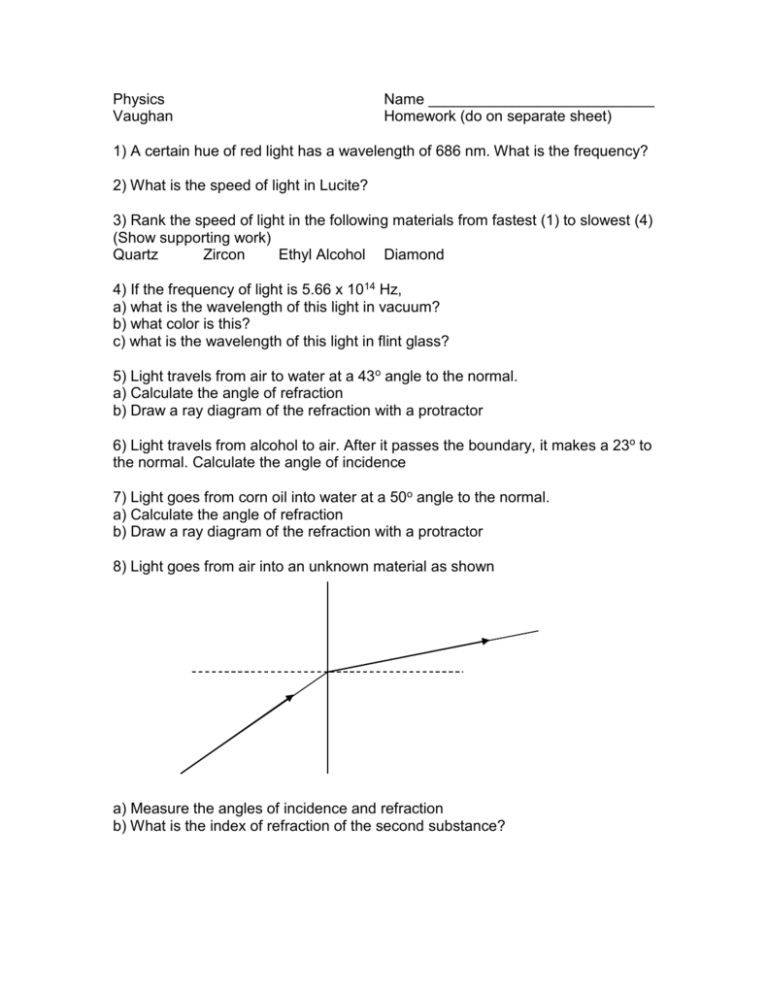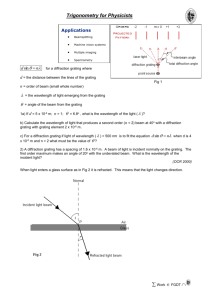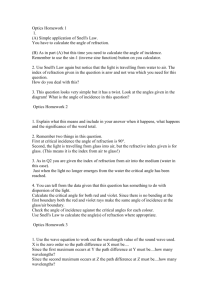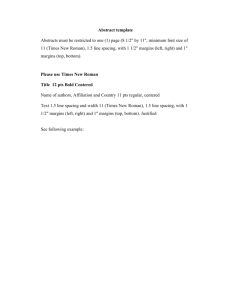Physics
advertisement

Physics Vaughan Name ___________________________ Homework (do on separate sheet) 1) A certain hue of red light has a wavelength of 686 nm. What is the frequency? 2) What is the speed of light in Lucite? 3) Rank the speed of light in the following materials from fastest (1) to slowest (4) (Show supporting work) Quartz Zircon Ethyl Alcohol Diamond 4) If the frequency of light is 5.66 x 1014 Hz, a) what is the wavelength of this light in vacuum? b) what color is this? c) what is the wavelength of this light in flint glass? 5) Light travels from air to water at a 43o angle to the normal. a) Calculate the angle of refraction b) Draw a ray diagram of the refraction with a protractor 6) Light travels from alcohol to air. After it passes the boundary, it makes a 23o to the normal. Calculate the angle of incidence 7) Light goes from corn oil into water at a 50o angle to the normal. a) Calculate the angle of refraction b) Draw a ray diagram of the refraction with a protractor 8) Light goes from air into an unknown material as shown a) Measure the angles of incidence and refraction b) What is the index of refraction of the second substance? 9) Light is traveling along in air and it encounters a glass of water but the glass of water has a layer of glycerol on top. The light is going down and to the right and hits the surface of the glycerol layer at a 45 degree angle to the normal at the dot. Draw the path of the light through the layers. Air Glycerol Water Crown Glass Air 10) Light is incident on a non-dispersive prism made of crown glass. You will need a protractor to measure angles. If the light enters parallel to the base, trace the path of the light ray through the prism. 11) Calculate the critical angle as light attempts to pass from a) water to air. b) diamond to air c) diamond to water d) corn oil to diamond 12) Light attempts to pass from flint glass to air. What happens to the light if a) the angle of incidence is 20o b) the angle of incidence is 37o c) the angle of incidence is 55o d) Sketch a picture for each interaction. 13) A 600 nm laser beam is incident on a diffraction grating with an average slit spacing of 0.2 mm. The resulting pattern is seen on a screen that is placed 2.0 meters from the slits. a) What is the spacing between the central maximum and the first order maximum? b) What is the spacing between the central maximum and the first order minimum? c) What is the spacing between the central maximum and the second order minimum? d) Compared to the intensity of the first order maximum, what will be true about the intensity of the second order maximum? 14). Light is incident on a double slit whose slits are separated by 0.03 mm. On a screen 3.4 meters away an interference pattern forms where the distance between the central bright line and the first order bright line is 9.1 mm. a) What is the wavelength of this light? b) What color is this? c) What is the frequency of this light? 15) Light with a frequency of 7.0 x 1014 Hz is incident on two slits that are separated by 0.26 mm. On a screen, the maxima are separated by 5.2 mm. a) What is the color of the light? b) How far away is the screen? c) Light is traveling from each of the slits to the screen and interfering when it gets there. What is the path difference between the light’s path from one slit to the first order maximum and the light’s path from the second slit to that same first order maximum? d) What would the path difference be for the first order minimum? 16) A diffraction grating has 800 lines per millimeter. This grating is used with UV light that has a wavelength of 210 nm. On a special phosphorescent screen that is 2.1 meters away an interference pattern forms. a) What is the average slit spacing of the diffraction grating? b) What is the separation between the central maximum and the third order maximum? c) What is the separation between the two 4th order minima? 17) A laser of violet light, 420 nm, is incident on a diffraction grating. The pattern is projected on a screen that is 1.5 meters away. The distance between the first and second order maximum is 2.3 cm. a) What is the average slit spacing? b) What would happen to the spacing between the maxima if red laser light were used? c) If the entire set up were immersed in water, what would happen to the spacing between maxima?










